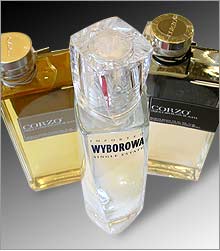 |
| Designer bottles: Wyborowa's Frank Gehry design flanked by Corzo's Fabien Baron. |
|
|
|
NEW YORK (CNN/Money) -
It certainly is more convenient to take a drink on the go nowadays.
After all, kegs of beer don't fit so well in golf bags. And casks of whisky place undue strain on airline seat-back trays.
Fortunately, some of the most ingenious minds of the last century have addressed such issues. The result: the box of wine, the miniature liquor bottle, the pre-mixed cocktail -- and the beer can, which celebrated its 70th anniversary Monday.
Before such subversive inventions, drinkers had three choices: Break their backs; drink warm, flat beverages; or consume their alcohol at the pub. Not surprisingly, most chose the latter, according to beer memorabilia collector Dan Morean, who owns the Web site Breweriana.com.
Before Prohibition, Morean says, on-premise drinking was by far the most popular choice. Filling up a jug and taking the brew home from a tavern was a distant second. But after Prohibition was repealed, beer makers started to experiment with cans, as a way to encourage people to drink at home.
According to the Brewery Collectibles Club of America, the first canned beer was Krueger's Special Beer, made by the Gottfried Krueger Brewing Company of Newark, N.J. It went on sale in Richmond, Va., 70 years ago Monday.
Since then, the beer can has undergone only a few major changes. One of which was the pull-tab, which debuted in 1962 and eliminated the need to punch a hole in a can's top -- a-la-shotgun style -- with a device curiously named the church key.
The second came with Guinness' invention of the 'widget' in 1988. The widget creates a full, draft-style head on the beer by using nitrogen to force the beer through a small hole in the bottom of the widget right after the can is opened, thus creating the bubbles to form the head.
Guinness, now part of drinks giant Diageo Plc. (down $0.15 to $54.63, Research), brought beer packaging to a new level. But the innovations are not limited to the malt-and-hops business.
Like premium beer, high-end spirits are also trying new packaging gimmicks to woo customers.
The latest trend in upscale alcohol is to recruit famous designers and architects to craft a bottle. Poland's Wyborowa recently commissioned Frank Gehry -- arguably the world's most famous living architect -- to design the container for its new premium Single Estate vodka.
Gehry came up with a sleek, subtly-twisted clear rectangle toped with a round cap in off-square housing. If the Guggenheim Bilbao were a bottle of booze, it would look like this.
Corzo tequila, a "super-premium" brand made by Bacardi, enlisted designer Fabien Baron to sculpt their new bottle. Baron has worked on corporate branding for a host of fashion companies and served as the creative director at French Vogue.
"It's only the beginning," said Gonzalo De La Pezuela, Bacardi's marketing director, who said future packaging innovations will come less in the form of physical bottles and cans but rather from the campaigns that surround increasingly specialized products catering to niche markets. "For the packaging to be relevant, it has to help the consumer look at the product in a different way."
It's a long way from that first can of Krueger's. On the other hand, consumers in 1935 probably thought it was strange to see beer in cans, too.

|